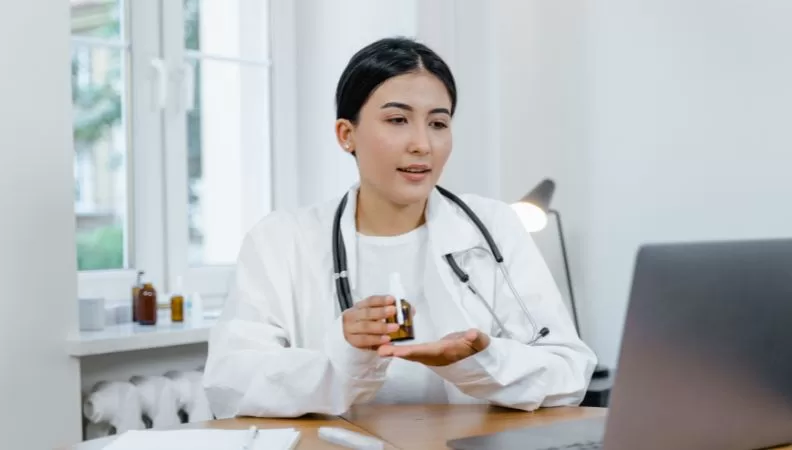Telemedicine: Bridging Healthcare Gaps in Rural Communities
Access to high-quality healthcare in rural areas is challenging due to limited facilities, remoteness, and a lack of specialists. Traditional healthcare often requires costly and time-consuming trips to doctors. Telemedicine for rural healthcare offers a solution by providing remote consultations, digital health services, and improved access, especially in rural communities.
In this article, we will focus on the contribution of telemedicine to the closure of the healthcare deficit in rural regions, discussing its opportunities, pitfalls, and future promise of technology in transforming rural healthcare.
What is Telemedicine: A Guide to Remote Healthcare Services
Telemedicine refers to the delivery of healthcare services through electronic communication technologies, such as video calls, phone consultations, and remote monitoring devices. This allows patients to be seen at a distance and to have consultations with medical staff from a distance, without the need to move them to the real world.
Telemedicine Services: Types and Benefits
Synchronous Telemedicine: Real-time consultations using video calls or phone calls.
Asynchronous Telemedicine (Store-and-Forward): Sharing medical data, e.g., pictures or test results, to be reviewed in the future.
Remote Patient Monitoring (RPM): Continuous monitoring of a patient’s health using digital devices that send data to healthcare providers.
Mobile Health (mHealth) Apps: Health apps that enable patients to track their conditions and communicate with healthcare professionals.
The Importance of Telemedicine in Rural Healthcare
Telemedicine is revolutionary for remote areas, offering a rich set of benefits that conventional medicine is often unable to deliver.
Improving Access to Healthcare in Remote Areas
Rural communities are often remote from healthcare facilities or experts, who therefore have to travel a significant distance. Telemedicine dissolves these barriers by providing patients with remote consultations in which they can access healthcare, no matter where they are.
Telemedicine: Reducing Travel Time and Costs in Healthcare
Long-range travel to receive medical care is both costly and time-consuming, especially for individuals who lack access to dependable transportation. Telemedicine does not require any physical travel and thus saves money and time as well.
Telemedicine: Increasing Access to Specialists in Rural Areas
Rural areas often face a shortage of specialists in various fields, such as cardiology, dermatology, or mental health. By means of telemedicine, individuals located in rurally served areas can be linked to a specialist through video consultations and receive specialist care without having to relocate to a nearby urban center.
Key Benefits of Telemedicine for Rural Populations
Telemedicine offers an array of benefits, which justifies the use of telemedicine as a means to enhance healthcare delivery in rural settings.
Enhancing Healthcare Accessibility for Underserved Populations
Rural populations experience healthcare access inequities often as a result of geographic separation from healthcare facilities or provider supply shortages. Telemedicine makes meeting this gap in all aspects possible by allowing them to obtain medical care from the comfort of their homes.
Improving Healthcare Outcomes Through Timely Consultations
By enabling faster access to medical advice, telemedicine reduces wait times and ensures that patients receive timely interventions. This can improve outcomes, particularly for patients with chronic conditions who require regular monitoring.
Reducing the Burden on Healthcare Systems
Telemedicine relieves the workload of local healthcare facilities by performing preventive and follow-up visits remotely. This frees up in-person appointments for more urgent cases.
Providing Convenient Follow-Up Care
Telemedicine can thus be used to provide greater convenience for patients with follow-ups, especially chronic conditions. By remotely monitoring patients’ health, healthcare providers can ensure that patients stay on track with their treatment plans.
Telemedicine’s Impact on Rural Healthcare Providers
Telemedicine also offers significant benefits to healthcare providers working in rural areas.
Expanding Reach and Patient Base for Rural Healthcare Providers
Rural clinicians can utilize telemedicine to overcome the limitations of their local area. This enables them to offer service to patients they may otherwise be unable to serve.
Facilitating Collaboration Between Healthcare Providers
Telemedicine facilitates better coordination and teamwork among healthcare providers, locally and over distance. There are advantages to rapid access to consultation with specialists and multidisciplinary care groups, thereby enhancing the quality of care rural patients receive.
Telemedicine: Reducing Provider Burnout and Improving Care
Telemedicine has the potential to reduce the burden on healthcare professionals by optimizing routine visits and follow-ups. This lowers the burden on clinicians and contributes to preventing burnout, a common issue in the rural setting and in the context of limited medical staff.
Challenges of Implementing Telemedicine in Rural Areas
Although telemedicine has many advantages, the implementation of telenutrition reports in rural areas also has some issues that need to be dealt with.
Limited Internet Connectivity and Technology Access
Reliable high-speed internet access is an essential prerequisite for telemedicine to work properly. But, in many rural communities, the internet is very inadequate, and it’s hard to use telehealth services.
Lack of Digital Literacy Among Patients and Providers
In some rural communities, patients and healthcare professionals may not know about telemedicine technology. This can create a barrier to adoption and hinder the effectiveness of telehealth initiatives.
Telemedicine: Regulatory and Licensing Issues in Healthcare
Telemedicine across state or national borders can raise regulatory concerns, such as the need for specific licensing requirements for healthcare providers to offer remote services. These regulations may vary between regions, creating challenges for widespread implementation.
Ensuring Privacy and Security of Patient Data
Safeguarding sensitive health information is of utmost importance. Telemedicine applications using electronic communication technology should follow strict regulations, e.g., the Health Insurance Portability and Accountability Act (HIPAA), in order to guarantee the privacy of information provided by patients.
The Future of Telemedicine in Rural Healthcare
Telemedicine has the capacity to further increase and evolve healthcare in rural areas. Moreover, it enables greater accessibility to medical professionals. Additionally, it reduces the need for travel, saving time and costs. Furthermore, telemedicine offers a more convenient way to receive consultations and treatments. As a result, rural communities can benefit from improved healthcare services. Ultimately, telemedicine can significantly bridge the healthcare gap in remote areas.
Integration with Wearable Health Devices for Remote Monitoring
The integration of wearable health devices with telemedicine platforms allows for continuous monitoring of patients’ vital signs, such as heart rate, blood pressure, and blood glucose levels. This could be used to enhance chronic disease management in the long term and in effect, reduce the requirement of face-to-face contact.
Expanding Telemedicine Access with Mobile Health Apps
The application of mobile health (mHealth) apps can be used to widen the scope of telemedicine by enabling a patient to see a clinician, monitor his/her health, and get reminders for medication or office visits.
Government and Policy Support for Rural Telemedicine Expansion
Government initiatives and policy support will be crucial in addressing the challenges of telemedicine implementation in rural areas, such as improving internet connectivity, offering financial incentives for providers, and ensuring regulatory alignment.
Conclusion
Telemedicine is a driving force in the reform of medical provision to the rural population, providing higher access, convenience, and better clinical outcomes for underserved people. Although internet access, technology access, and regulatory issues continue to pose problems, the future of telemedicine is upbeat. As technology, policy support, and integration with digital health improve, telemedicine has the potential to transform healthcare delivery and reduce disparities in rural areas.



